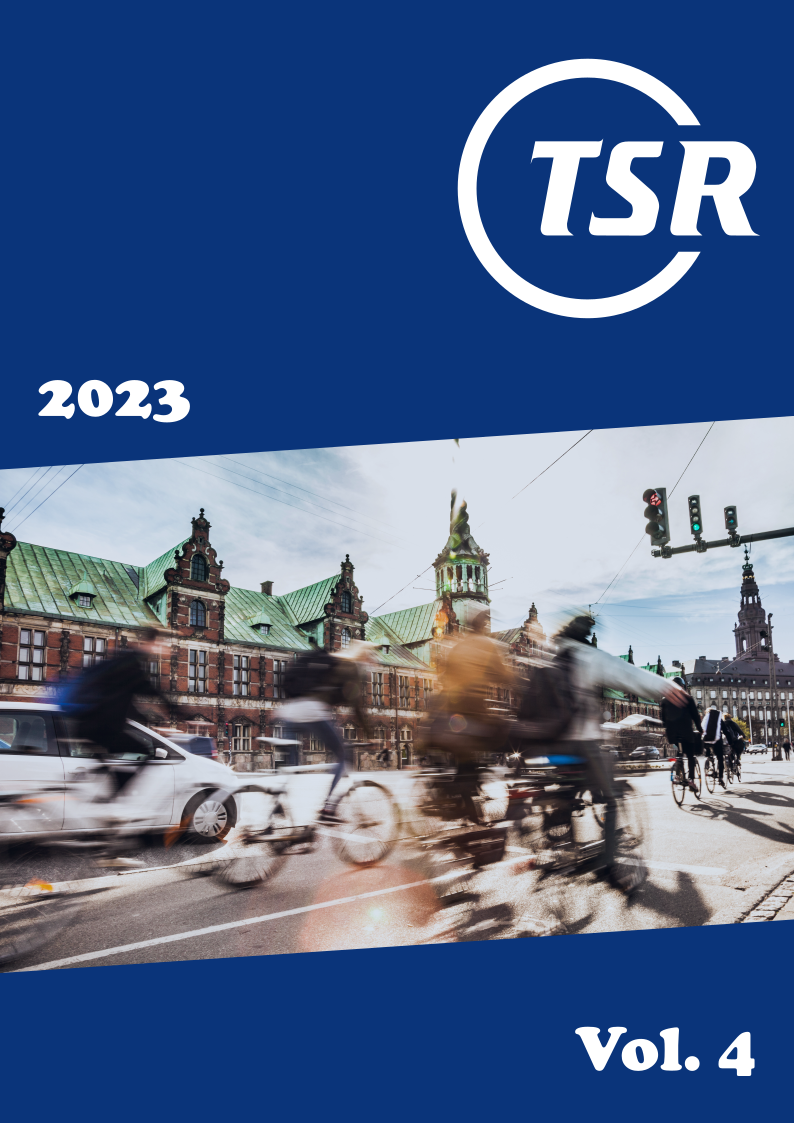Safety of horizontal curves on rural two-lane roads in Norway
DOI:
https://doi.org/10.55329/hkbk3638Keywords:
accident prediction model, horizontal curve, negative binomial regressionAbstract
Horizontal curves are found on all roads. The relationship between the characteristics of horizontal curves and the number of accidents is complex and no previous study has included all factors that are potentially influential for accidents. This paper presents a study of 63 969 horizontal curves on rural two-lane roads in Norway. Accident prediction models including more characteristics of horizontal curves than used in any previous study were developed. Most of the characteristics were found to be related to the number of accidents. Most coefficients were consistent with those found in previous studies, but some findings were surprising. Compound curves, which are curves in which radius varies throughout the curve, were found to be safer than circular or nearly circular curves. A steeper slope of a vertical grade before a curve is associated with fewer accidents.
Downloads
References
Bauer, K. M., D. M. Harwood (2013), 'Safety Effects of Horizontal Curve and Grade Combinations on Rural Two-Lane Highways', Transportation Research Record, 2398, 37–49. DOI: https://doi.org/10.3141/2398-05
Cardoso, J. L. (2005), 'Safety assessment for design and redesign of horizontal curves', 3rd International Symposium on Highway Geometric Design, Chicago, IL, USA, 29 June–2 July 2005.
Christensen, P., A. Ragnøy (2006), 'Vegdekkets tilstand og trafikksikkerhet: Betydningen av spordybde, ujevnhet og endringer i tverrfall for ulykkesrisikoen [The condition of the road surface and safety]', Institute of Transport Economics (Oslo, Norway).
Dhahir, B., Y. Hassan (2019), 'Using horizontal curve speed reduction extracted from the naturalistic driving study to predict curve collision frequency', Accident Analysis & Prevention, 123, 190–199. DOI: https://doi.org/10.1016/j.aap.2018.11.020
Dietze, M., G. Weller (2011), 'Applying speed prediction models to define road sections and to develop accident prediction models: A German case study and a Portuguese exploratory study', RISMET project (ERANET), Deliverable 6.2.
Easa, S. M., Q. C. You (2009), 'Collision prediction models for three-dimensional two-lane highways', Transportation Research Record, 2092, 48–56. DOI: https://doi.org/10.3141/2092-06
Elvik, R. (2017), 'Can evolutionary theory explain the slow development of knowledge about the safety level built into roads?', Accident Analysis & Prevention, 106, 166–172. DOI: https://doi.org/10.1016/j.aap.2017.06.008
Elvik, R. (2013), 'International transferability of accident modification functions for horizontal curves', Accident Analysis & Prevention, 59, 487–496. DOI: https://doi.org/10.1016/j.aap.2013.07.010
Elvik, R. (2019), 'The more (sharp) curves, the lower the risk', Accident Analysis & Prevention, 133, 105322. DOI: https://doi.org/10.1016/j.aap.2019.105322
Elvik, R. (2022), 'Which is the most important for road safety—road design or driver behavioural adaptation?', Traffic Safety Research, 2, 000009. DOI: https://doi.org/10.55329/pvir7839
Evans, L. (1985), 'Human Behavior Feedback and Traffic Safety', Human Factors, 27(5), 555–576. DOI: https://doi.org/10.1177/001872088502700505
Findley, D., J. E. Hummer, W. Rasdorf, C. V. Zegeer, T. J. Fowler (2012), 'Modeling the impact of spatial relationships on horizontal curve safety', Accident Analysis & Prevention, 45, 296–304. DOI: https://doi.org/10.1016/j.aap.2011.07.018
Fridstrøm, L., J. Ifver, S. Ingebrigtsen, R. Kulmala, L. Krogsgård Thomsen (1995), 'Measuring the contribution of randomness, exposure, weather, and daylight to the variation in road accident counts', Accident Analysis & Prevention, 27, 1–20. DOI: https://doi.org/10.1016/0001-4575(94)E0023-E
Geedipally, S. R., M. P. Pratt, D. Lord (2019), 'Effects of geometry and pavement friction on horizontal curve crash frequency', Journal of Transportation Safety and Security, 11, 167–188. DOI: https://doi.org/10.1080/19439962.2017.1365317
Gooch, J. P., V. V. Gayah, E. T. Donnell (2016), 'Quantifying the safety effects of horizontal curves on two-way, two-lane rural roads', Accident Analysis & Prevention, 92, 71–81. DOI: https://doi.org/10.1016/j.aap.2016.03.024
Gooch, J. P., V. V. Gayah, E. T. Donnell (2018), 'Safety performance functions for horizontal curves and tangents on two lane, two way rural roads', Accident Analysis & Prevention, 120, 28–37. DOI: https://doi.org/10.1016/j.aap.2018.07.030
Hanno, D. (2004), 'Effect of the combination of horizontal and vertical alignments on road safety'.
Hauer, E. (1999), 'Safety and the Choice of Degree of Curve', Transportation Research Record, 1665, 22–27. DOI: https://doi.org/10.3141/1665-04
Khan, G., A. R. Bill, M. Chitturi, D. A. Noyce (2013), 'Safety Evaluation of Horizontal Curves on Rural Undivided Roads', Transportation Research Record, 2386, 147–157. DOI: https://doi.org/10.3141/2386-17
Llopis-Castello, D., F. J. Camacho-Torregrosa, A. Garcia (2018), 'Calibration of the internal consistency index to assess road safety on horizontal curves of two-lane rural roads', Accident Analysis & Prevention, 118, 1–10. DOI: https://doi.org/10.1016/j.aap.2018.05.014
Lord, D. (2006), 'Modeling motor vehicle crashes using Poisson-gamma models: Examining the effects of low sample mean values and small sample size on the estimation of the fixed dispersion parameter', Accident Analysis & Prevention, 38(4), 751–766. DOI: https://doi.org/10.1016/j.aap.2006.02.001
Milton, J., F. Mannering (1998), 'The relationship among highway geometries, traffic-related elements and motor-vehicle accident frequencies', Transportation, 25, 395–413. DOI: https://doi.org/10.1023/A:1005095725001
Montella, A., L. Colantuoni, R. Lamberti (2008), 'Crash prediction models for rural motorways', Transportation Research Record, 2083, 180–189. DOI: https://doi.org/10.3141/2083-21
Persaud, B., R. Retting, C. Lyon (2000), 'Guidelines for identification of hazardous highway curves', Transportation Research Record, 1717, 14–18. DOI: https://doi.org/10.3141/1717-03
Saleem, T., B. Persaud (2017), 'Another look at the safety effects of horizontal curvature on rural two-lane highways', Accident Analysis & Prevention, 106, 149–159. DOI: https://doi.org/10.1016/j.aap.2017.04.001
Shalkamy, A., K. El-Basyouny (2020), 'Multivariate models to investigate the relationship between collision risk and reliability outcomes on horizontal curves', Accident Analysis & Prevention, 147, 105745. DOI: https://doi.org/10.1016/j.aap.2020.105745
Strandvik Haugvik, E. (2018), 'Risikokurver. Analyse av utforkjøringsrisikofaktorer på 2-feltsveger [Analysis of run-off risk factors on 2-field roads]', Statens vegvesen, region øst.
Wilde, G. J. S. (1982), 'The Theory of Risk Homeostasis: Implications for Safety and Health', Risk Analysis, 2(4), 209–225. DOI: https://doi.org/10.1111/j.1539-6924.1982.tb01384.x
Zegeer, C. V., J. R. Stewart, F. M. Council, D. W. Reinfurt, E. Hamilton (1992), 'Safety Effects of Geometric Improvements on Horizontal Curves', Transportation Research Record, 1356, 11–19.
Published
How to Cite
Issue
Section
License
Copyright (c) 2023 Rune Elvik, Espen Strandvik Haugvik

This work is licensed under a Creative Commons Attribution 4.0 International License.









